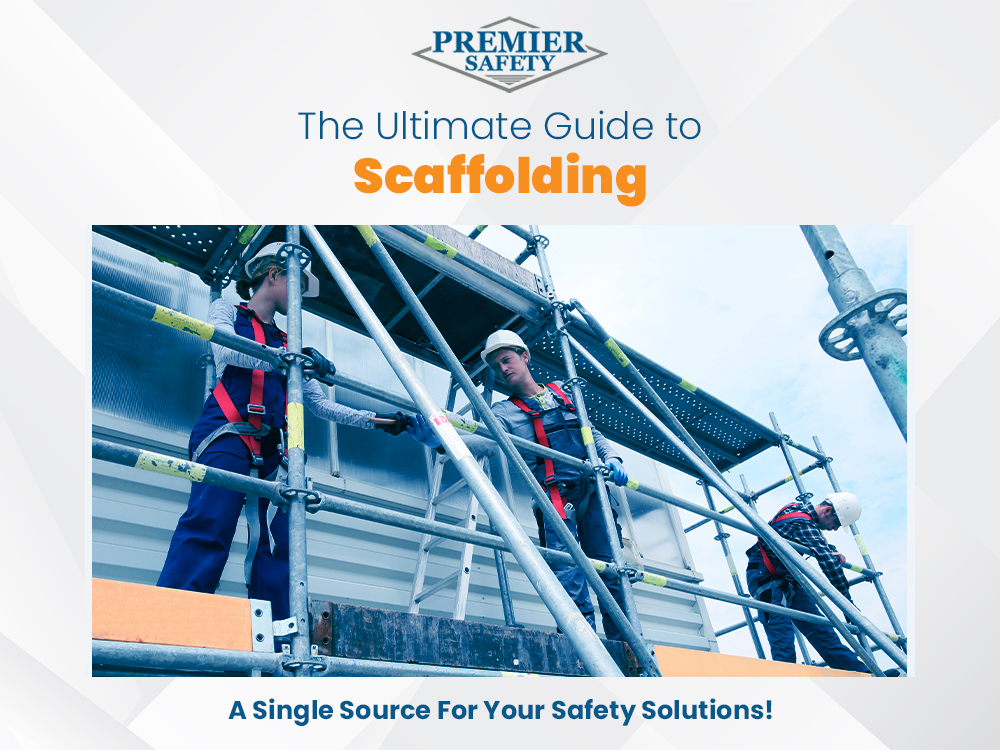What Is Scaffolding? The Ultimate Guide to Scaffolding
Posted by Michael Womack - Premier Safety on Feb 29th 2024
 Imagine standing on the edge of a structure, high above the ground, with nothing but the air whispering past you.
Imagine standing on the edge of a structure, high above the ground, with nothing but the air whispering past you.
Now, imagine standing on a strong and dependable scaffold, showing off the cleverness and dedication of builders.
Scaffolding is more than just a structure; it's a key part of construction projects, making it safe and easy to reach high places.
In this guide, we'll go over the basics, like key standards, rules, and tips to keep you safe and successful every time you climb. Let's learn more and protect our projects with Premier Safety, your go-to for all safety solutions.
What Is Scaffolding?
Scaffolding is the temporary structure outside of a building used when building, repairing, or cleaning a building. Scaffolding is normally made with metal poles and wooden planks.
OSHA's Watchful Eye: Scaffolding Standards Unveiled
What is the OSHA violation for scaffolding?
OSHA strictly enforces rules to stop falls and ensure structures are solid. Most violations are because of incorrect setup, missing guardrails, or inadequate fall protection.
What is the OSHA code for scaffolding?
OSHA's rules are in 29 CFR 1926.451. This code covers all aspects including design, construction, inspection, and use, ensuring they meet high safety standards for work.
The Trinity: Safety, Stability, and Standards
What is the 3 to 1 rule?
The 3-to-1 rule is a critical guideline ensuring stability and safety. It says that for every three feet tall a freestanding scaffold is, the base must be one foot wide. This rule is pivotal in preventing toppling and maintaining balance.
Golden Rules: The Pillars of Safety
Safety relies on a few key rules that are crucial for every project:
1. Always Wear Personal Protective Equipment (PPE): hard hats, non-slip boots, and harnesses are non-negotiable.
2. Train All Workers: Make sure every worker receives training on safety and how to operate equipment.
3. Inspect Regularly: Check for potential hazards before using each time.
Decoding Safety: The 4 to 1 Height Ratio
What does 4 1 mean?
For every four units of height, the base should be one unit away from the structure. This ratio ensures stability and safety when accessing higher levels.
Elevated Safety: Scaffolding Rail Requirements
At what height are rails needed?
OSHA mandates that scaffolds over 10 feet high must have guardrails. This critical safety feature prevents falls, a leading cause of injury on construction sites.
Reaching New Heights
What is the maximum height of scaffolding?
The maximum height depends on its type and construction but generally, scaffold towers can extend up to several stories. Specific height limits should align with manufacturer recommendations and OSHA guidelines to ensure safety.
The Plank Principle: Scaffolding Load Limits Explained
Is a 10-foot scaffold plank only allowed to deflect 2 inches or 1/60th of its span?
Yes, OSHA standards stipulate that scaffold planks should not deflect more than 1/60th of their span. For a 10-foot plank, this means a maximum deflection of 2 inches, ensuring the plank's strength and integrity under load.
Should planks have a stamp?
You don't need to stamp every scaffold plank, but we recommend using graded and stamped lumber. This ensures the material meets specific strength and quality standards, contributing to overall scaffold safety.
When the Ground is Better: Prohibited Scaffold Use
When is working on a scaffold not allowed?
You must not work on scaffolds during high winds, storms, or if they are icy or snowy. These conditions significantly increase the risk of falls and injuries.
Climbing with Confidence
Does OSHA require training?
Yes, OSHA requires that all workers who erect, dismantle, move, or work on scaffolds receive proper training. This ensures they understand the potential hazards and how to safely navigate them.
FAQ: Your Scaffold Safety Questions Answered
Q: Can I use any material for planking?
A: Only materials that meet OSHA's strength and quality requirements should be used for planking to ensure safety.
Q: How often should scaffolds be inspected?
A: It should be inspected before each shift and after any event that could affect their structural integrity.
A Real-Life Story: The Importance of Adherence to Safety
Imagine John, a seasoned construction worker with years of experience under his belt. One day, while working on a scaffold without proper guardrails, he lost his balance.
This could have been a disaster, but luckily, John was wearing his safety harness, attached securely to a strong part of the scaffold.
This story underscores the importance of following all safety protocols, no matter how experienced you are. Compliance matters, but going home safely every day is what's truly important.
Engage and Ask: Your Thoughts on Scaffold Safety
How do you ensure safety on your projects?
Share your practices and experiences in the comments below. Your insights could help others improve their safety standards!
The Premier Safety Promise: Your Partner in Safety and Success
At Premier Safety, we know how important safety is for your projects and workers. We offer a wide range of safety equipment and solutions to help make your workplace safer and more efficient. We are dedicated to supporting you. From training and equipment to expert advice, we're here to support your safety goals every step of the way.
Connect with Premier Safety today to ensure your equipment is as safe and reliable as the work you do. Together, we can reach new heights in safety and performance.

